The first and foremost rule of carrying is: do not permit yourself to get injured when doing so.
What Is the Safest Way to Carry Boxes
Professional movers carry boxes on their back using a
If you do have to carry things in front of you, then carefully watch where you’re walking and don’t let your load hinder your field of vision.
However, it is much better to carry things on your back as the mover in the photo is doing – he is carrying 4 boxes all taped together from top to bottom so he straps them the other way around to easily carry them.
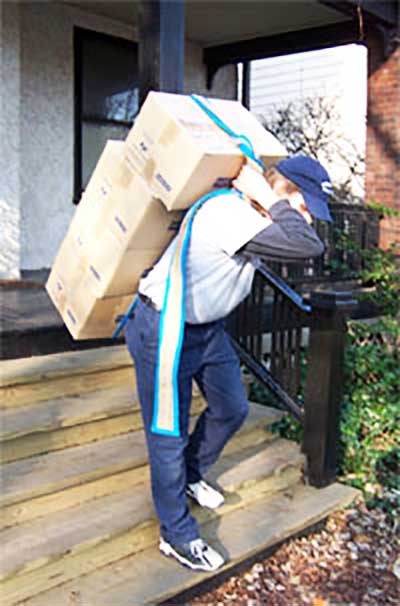
The mover in the above picture is using the tightness of the strap to hold his 4 boxes together from top to bottom. This
Because of the risk and the weight involved most amateurs should at first limit themselves to carrying only 3 boxes on their back with the
Stack boxes on a sturdy table (be sure to cover the table with a pad so that you don’t scratch it). Do not use a table for stacking that has weak legs and do not use a pedestal style table because the weight of the boxes can break these tables. It’s best to use a strong 4-legged table or a maybe even a counter to set up your strap carry (hump). This is being done in the picture below.

If only one or two things need to be carried, use the

Keep in mind that carrying heavy items can put a lot of strain on your heart, especially if you’re carrying things to/from a second floor or higher. It would be better to avoid such heavy carrying and hire professional movers to do the job for you. If you must carry some things, then just take your time, be extra careful, and take plenty of rest breaks.
For really big, heavy carries professional movers will use as many men as it takes to do the job safely in order to avoid personal injury and damages, like with 7 men on this 9′ – 1200 lb. monster concert grand piano in the picture below! Notice that except for the safety man on the left (who’s there to keep the piano from going too far over as it’s being tipped up towards him) all of the professionals carrying the load are in a crouch with straight backs, gripping their share of the weight tightly to them.
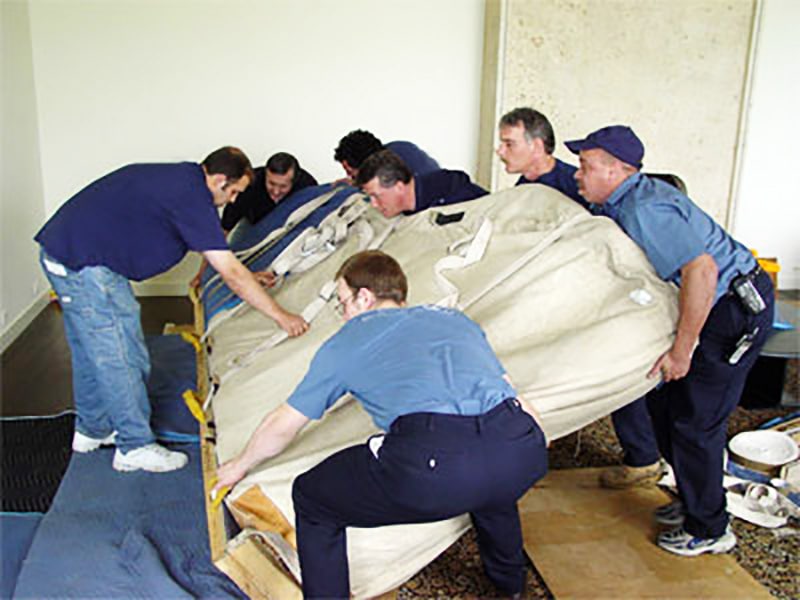
Some of these men have actually been moving furniture for decades!
This is just how they do it without getting back injuries.
How to Safely Lift and Carry Heavy Items
To lift any load; begin by bending your knees and squatting down in front of it, as the man at the bottom of the piano (in the above picture) is doing. Then tuck your pelvis in tight to the load. Next, grab and hug the load in close to you, and then lift yourself and the load using your strong leg muscles while keeping your back straight (just exactly as all of the movers pictured above are doing).
Try to never bend your back instead of your knees to pick things up.

Think about this – how you carry a load and how you put the load down is just as important as how you pick it up. So, don’t twist or bend when carrying a load because you can easily wrench your back that way. Instead, if you must turn, turn your whole body using your legs, just as the professional mover is doing in the picture above.
Try to never bend your back during a lift, a carry, or a set down.
When setting a load down always keep your back aligned straight and stay balanced. Then bend at the knees and gradually slide the load down your body until you can put it comfortably all the way down to the ground and release it (without pinching your fingers or dropping it).
When two men are carrying a big item, always have them face each other.
This way they can each grip the piece tightly to themselves and they can easily communicate with each other as they move along. Granted, the front person has to walk backward as he carries the piece but that’s only a minor disadvantage.
This principle is so important that even the military is using it for their latest equipment carrying robots.
When going
If the person in front tries to walk facing forward and away from the other one, he cannot keep his grip on the piece because he’s constantly moving away from it. So, he won’t be able to avoid dropping it!
When the two people face each other, the back mover helps
At a set of stairs, the bottom person slows the pace down to allow the top person to feel with his feet for his footing on the stairs. Once the top person has his footing he has to slow down for the bottom person to then do the same.
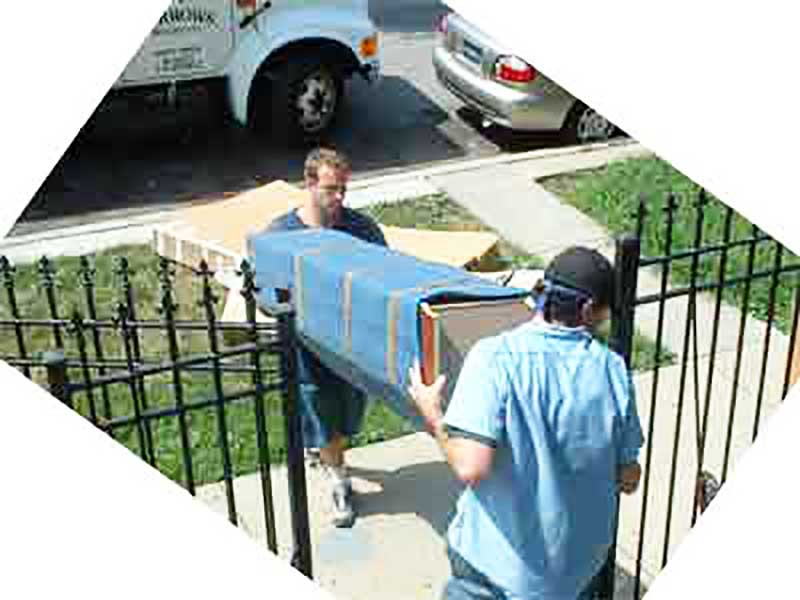
The two people carrying a heavy item must work together and communicate well to avoid personal injury and/or damage to a big expensive furniture piece.
If you’re going up stairways or ramps with a big load like an armoire or a dresser, use a strong, long strap like a
If you’re at the bottom of a big piece, as an amateur you should always have a third person with you to help carry the weight – the two of you can pull the bottom of the piece out from where it’s standing, tipping it back and up to the person on top who’s standing behind it.
The top man should use the
The bookcase pictured below is not that heavy, so there is only one professional mover needed to push the weight up from the bottom. But amateurs should always have two men on the bottom in similar circumstances, just for safety’s sake.
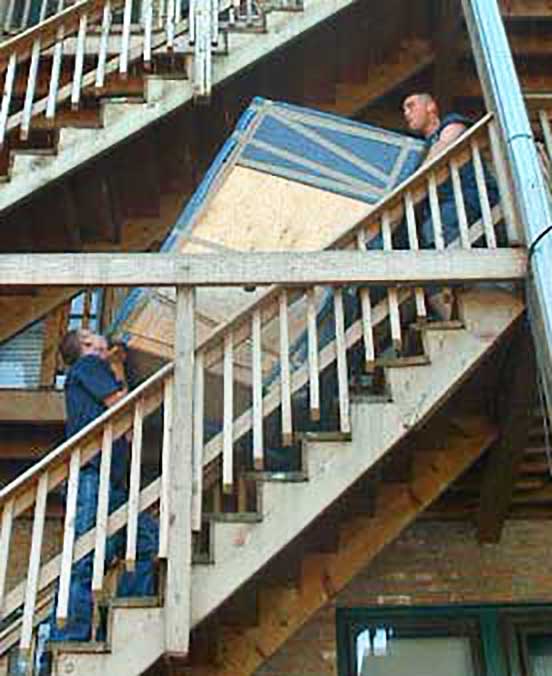
Notice in this picture that the bottom mover has his hands up high on the bottom of the piece to brace its weight against his chest while keeping his back straight. He’s not holding it low which would put him totally out of balance. It is only possible for him to do so without falling backward because the top man is pulling the piece’s weight up using the
Without a
This technique is much easier than any other method of moving heavy items because it does so many things right, all at once. The weight is evenly distributed among the three men as they traverse the stairs. They all can use good posture throughout the carry so their backs are protected from

In the above picture, three men (one unseen on the right) are carrying this upright piano up a whole flight of stairs. Again, you can see that the top man is carrying his portion of it with the
This picture shows that at this point the bottom men are well under the piano, lifting most of its weight. When they get to the very top of the stairway two steps further, they will just deposit the piano still on the dolly, all ready to roll on.
In the picture below you can see both men under the piano lifting it on the dolly. Notice the nice handhold this particular dolly allows them to have which makes the carry easier.
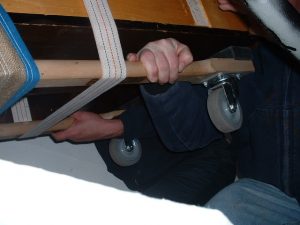
Here is a good close-up picture of the way the

Good to remember: Never allow a big piece to be tipped over from the top towards you when you’re positioned below its bottom, standing on a ramp or on steps. When this mistake is made the top man cannot help but lose control of the piece as it tips and then falls towards the bottom man and then that bottom man will have to stretch up to reach up and try to catch the piece to slow its descent. No matter how strong you may be, you can be quickly overwhelmed and thrown backward by the downwards momentum of the large furniture piece as it passes its fulcrum balance point and gravity throws it down upon you. If this happens and you do lose control of the piece you’ll probably get hurt as it drops on you and also the piece will certainly get damaged.
So, always pull out the bottom of a big piece that’s positioned above you and tip it back into the top man’s chest. Padding its bottom facilitates this movement because a pad makes it easy to slip out and protects the finish on the bottom edges.
Below is a picture of a man easily carrying a well-padded armchair by gripping the pad at the top of the chair and balancing it on his back. The taped, tightly secured pads allow him to easily do this nice moving technique.
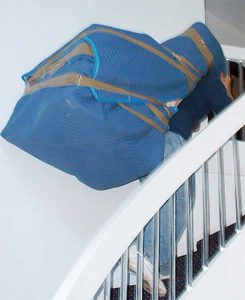
We do not recommend this technique to amateurs because without experience you are liable to hit something like a chandelier or a ceiling fan with the top of the furniture piece. You can also easily accidentally swing the furniture piece into something. Better to just carry it with two men as is being done with the couch pictured below.
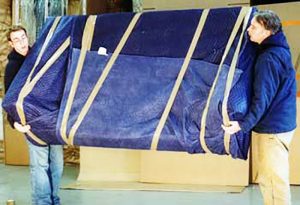
Remember, lifting and carrying each item correctly during a move saves your back, your strength


